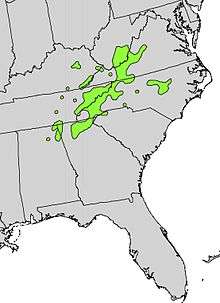Rhododendron catawbiense
| Rhododendron catawbiense | |
|---|---|
 | |
| Rhododendron catawbiense growing wild on Mount Mitchell, North Carolina | |
| Scientific classification | |
| Kingdom: | Plantae |
| (unranked): | Angiosperms |
| (unranked): | Eudicots |
| (unranked): | Asterids |
| Order: | Ericales |
| Family: | Ericaceae |
| Genus: | Rhododendron |
| Subgenus: | Hymenanthes |
| Section: | Ponticum |
| Subsection: | Pontica |
| Species: | R. catawbiense |
| Binomial name | |
| Rhododendron catawbiense | |
 | |
| Natural range | |
Rhododendron catawbiense, with common names Catawba rosebay,[1] Catawba rhododendron,[2] mountain rosebay,[2] purple ivy,[2] purple laurel,[2] purple rhododendron,[2] red laurel,[2] rosebay,[2] rosebay laurel,[2] is a species of Rhododendron native to the eastern United States, growing mainly in the southern Appalachian Mountains from Virginia south to northern Alabama.
It is a dense, suckering shrub growing to 3 m tall, rarely 5 m. The leaves are evergreen, 6–12 cm long and 2–4 cm broad. The flowers are 3-4.5 cm diameter, violet-purple, often with small spots or streaks. The fruit is a dry capsule 15–20 mm long, containing numerous small seeds.
The species is named after the Catawba River.[3]
Classification
Rhododendron catawbiense belongs to the Subgenus Hymenanthes, within which it is further assigned to Section Ponticum and Subsection Pontica. The latter — one of the 24 subsections of Ponticum — also contains about a dozen other species. The taxonomy has been confused by a tendency to group all large leaved Rhododendrons under the catch-all R. catawbiense.[4]
Cultivation and uses
Rhododendron catawbiense is cultivated as an ornamental plant, popular both in North America and in parts of Europe. It is primarily grown for its spring flower display. Outside of its native range, many cultivars and hybrids have been created,[5] such as 'Purple Elegans', 'Roseus Elegans', and 'Grandiflorum'.
See also
References
- ↑ "Rhododendron catawbiense". Natural Resources Conservation Service PLANTS Database. USDA. Retrieved 21 October 2015.
- 1 2 3 4 5 6 7 8 Wagstaff, D.J. (2008). International Poisonous Plants Checklist: An Evidence-Based Reference. Taylor & Francis. ISBN 9781420062533.
- ↑ André Michaux. Flora Boreali'Americana. 1803. ("Hab. in montibus excelsis Carolinse septentrionalis; juxta originem amnis Catawba")
- ↑ University of Connecticut: Rhododendron catawbiense Archived 2012-07-12 at the Wayback Machine.
- ↑ R. catawbiense cultivars . accessed 1.31.2013
- "Rhododendron catawbiense". Germplasm Resources Information Network (GRIN). Agricultural Research Service (ARS), United States Department of Agriculture (USDA).
- Milne, R. I., & Abbott, R. J. (2000). Origin and evolution of invasive naturalized material of Rhododendron ponticum L. in the British Isles. Molecular Ecology 9: 541-556 Abstract.
External links
| Wikimedia Commons has media related to Rhododendron catawbiense. |